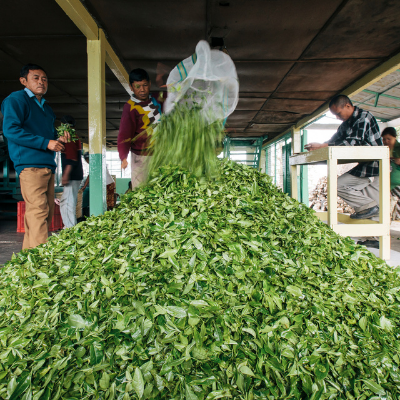
The 4 Tea Types you Need to Know
There are a number of different types of tea, but whether black, oolong, green or white, each is made from the leaves and buds plucked from a single plant, Camelia sinensis. It is what happens to the plucked leaves during the subsequent processing stage that determines which of the tea types it then becomes.
These types of tea share common characteristics and along with geographical origin, play an important role in a tea’s unique flavour and aroma. So what are these tea types, and what do they taste like?
What is Black Tea?
Confusingly known in China as a ‘red tea’, thanks to the dark red liquors they produce, black tea is perhaps the best known and certainly the most widely drunk of the tea types in the UK. The ubiquitous English Breakfast, for example, is a blend of black teas from different origins.
The distinguishing feature of black tea production is the full oxidation of the freshly plucked tea leaf. After the leaves are picked, they are rolled and gently bruised, kickstarting a process of oxidation. This process of enzymes in the leaf meeting with oxygen in the air turns the leaves from the green we see on the bush to the brown we recognise as tea, before finally being dried. The result of having being left to ‘full oxidise’ is the development of dark, robust flavours, ranging from India’s rich, malty Assams, through China’s Keemuns with their bittersweet notes of dark chocolate, to lively cups of East Africa’s single origin black teas with hints of fruit and caramel.


What is Green Tea?
Compared to the many processes that black tea goes through, green tea production is relatively simple. Where the various steps in black tea prepare the leaf for oxidation, the focus of green tea production is to avoid oxidation altogether and instead deactivate the enzymes in the leaf as early as possible. After the leaves are picked, they are gently withered and then immediately heated to prevent any oxidation taking place. This latter part is known as ‘kill-green’ and the method chosen, such as wok-firing or steaming, plays an important role in the flavour of the finished tea. The lack of oxidation is what gives green tea its vibrant green colour and fresh, vegetal character. Green teas are surprisingly diverse, ranging from the sweet, floral character of a Chinese green to an intense, sweet-savoury Japanese Sencha, the flavour changing depending on where the leaves are grown and how the leaves are heated.


What is Oolong Tea?
Oolong, or Wu Long meaning ‘black dragon’, is, in terms of oxidation, a simple halfway house between black and green tea. However, the skill and time required to craft the best oolongs make this tea type quite unique. Unlike black teas which are allowed to oxidise fully, Oolongs are known as semi-oxidised, meaning that in this instance the oxidation process is halted at a controlled point. From lighter ‘green’ oolongs to darker, more heavily oxidised oolongs, it is this varying level of oxidation and the craft involved in their production that make this tea type so exciting, with a huge spectrum of flavour. Expect everything from delicate floral and tropical fruit notes from lighter, ‘green’ oolongs to black cherry and cacao from their darker counterparts.


What is White Tea?
The least processed of all tea types, white teas are highly-prized the world over. Only the youngest, finest leaves and buds are painstakingly plucked, the best of which are harvested in Spring, before being gently withered and dried. Many mistakenly believe that white teas are the least oxidised of all tea types, but in fact, while the maker will neither provoke nor prevent it, natural oxidation does occur during the long and carefully controlled withering stage. This meticulous processing is where much of the intensity of its characteristic aroma and sweetness develops, but is also means the best white teas are not only highly prized but also highly priced. When done with skill, the result, however, is very much worth it. From the best white teas you can expect a fresh, delicate, Champagne-coloured cup with character ranging from the gentle honeysuckle of Silver Needle, to the more full-bodied White Peony, brimming with melon-like sweetness.


What about Herbal Tea?
Herbal teas have never been so popular, with tea drinkers increasingly switching to herbs when looking to reduce their caffeine intake, as well as taking advantage of their reported health benefits. But what is Herbal Tea? Unlike all other tea types, such as black, oolong, green and white, herbal ‘teas’ do not actually come from the tea plant, Camelia sinensis. In fact, strictly speaking, herbs shouldn’t really be called teas at all, but rather infusions or tisanes, as each are unique in how and where they grow, as well as their flavour and properties. They can be made from fresh or dried flowers, leaves, seeds or even roots - a herbal tea is therefore simply an infusion of a particular herb in hot water.
Herbal teas or tisanes offer a rainbow of colours and a wide spectrum of flavours to match. Expect anything from a fresh, palate-cleansing Peppermint to a zingy Lemongrass, a calming, honey-sweet Chamomile to a sweet-sour Hibiscus.





